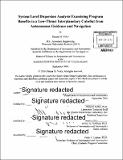| dc.contributor.advisor | Philip D. Hattis and Jeffrey A. Hoffman. | en_US |
| dc.contributor.author | Velez, Dianna M. (Dianna Maria) | en_US |
| dc.contributor.other | Massachusetts Institute of Technology. Department of Aeronautics and Astronautics. | en_US |
| dc.date.accessioned | 2017-02-22T19:01:26Z | |
| dc.date.available | 2017-02-22T19:01:26Z | |
| dc.date.copyright | 2016 | en_US |
| dc.date.issued | 2016 | en_US |
| dc.identifier.uri | http://hdl.handle.net/1721.1/107055 | |
| dc.description | Thesis: S.M., Massachusetts Institute of Technology, Department of Aeronautics and Astronautics, 2016. | en_US |
| dc.description | Cataloged from PDF version of thesis. | en_US |
| dc.description | Includes bibliographical references (pages 162-165). | en_US |
| dc.description.abstract | Ground based measurements through the Deep Space Network (DSN) are unlikely to be available as often for CubeSats as for prior deep space programs because higher priority missions will take precedence for access to the limited and expensive DSN resource. Consequently, to make the most of CubeSats in deep space, dependence on the ground must be minimized. In this research a closed-loop Linear Covariance (LinCov) analysis was performed to quantify the effects of the guidance and navigation (GN) system on trajectory dispersions for a low-thrust CubeSat in route to entry-interface conditions at Mars. Applicable mission plan concepts, appropriate analysis settings, as well as required mission performance used in the analysis were based on input collected from industry as well as criteria from prior Mars missions and the Deep Space 1 mission. Information was gathered regarding expected ground-derived orbit determination accuracy levels as a function of decreased DSN use. Optical navigation based on line-of-sight measurements of Mars was then investigated as a means to maintain onboard navigation accuracy despite reduced DSN coverage. The ability of onboard optical navigation to reduce needed ground tracking frequency and associated costs was found practical for interplanetary cruise. The expected resulting financial benefits from decreased DSN were quantified. Recommendations for onboard GN system capabilities and mission goals are made. LinCov was also explored as the core of a basic onboard mission planner that could enable more autonomous CubeSat interplanetary trajectory management. | en_US |
| dc.description.statementofresponsibility | by Dianna M. Velez. | en_US |
| dc.format.extent | 165 pages | en_US |
| dc.language.iso | eng | en_US |
| dc.publisher | Massachusetts Institute of Technology | en_US |
| dc.rights | MIT theses are protected by copyright. They may be viewed, downloaded, or printed from this source but further reproduction or distribution in any format is prohibited without written permission. | en_US |
| dc.rights.uri | http://dspace.mit.edu/handle/1721.1/7582 | en_US |
| dc.subject | Aeronautics and Astronautics. | en_US |
| dc.title | System level dispersion analysis examining program benefits to a low-thrust interplanetary CubeSat from autonomous guidance and navigation | en_US |
| dc.type | Thesis | en_US |
| dc.description.degree | S.M. | en_US |
| dc.contributor.department | Massachusetts Institute of Technology. Department of Aeronautics and Astronautics | |
| dc.identifier.oclc | 971022914 | en_US |
